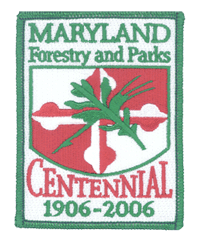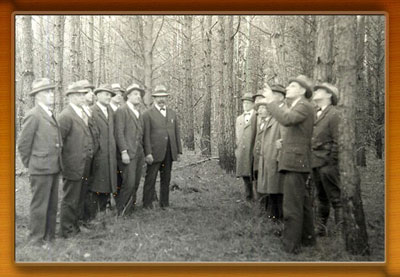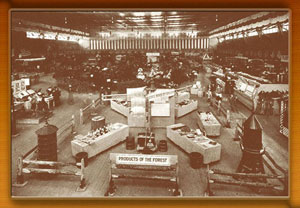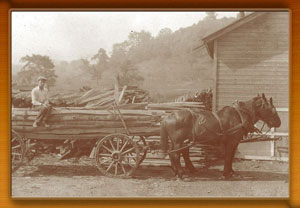 Scientific Forestry And Urban Progressivism:
Scientific Forestry And Urban Progressivism:
The Development of the Maryland Board of Forestry, 1906 to 1921
by Robert F. Bailey
Spreading the Gospel of Scientific Forestry
The Forestry Board’s decision to
hire Fred Wilson Besley was perhaps as significant as the creation of the
Forestry Board itself. Besley would serve as Maryland State Forester for 36
years—providing the Board (and later the Department) of Forestry with a
stabilizing force. Described by his descendents as humorless and strict, with a
penchant for noting meticulous detail, Besley’s personality was perfectly suited
for the rigors of the forestry profession.20
The Sun, impressed by Besley’s
resume, reported that “he did practical field work in nearly all branches of
service, embracing a field extending from Maine to Texas as far west as
Colorado.” His experience in the west “gave him a wide acquaintance with the
problems of city water supplies by means of tree planting on denuded mountain
watersheds.”21 Offered the State Forester position in May 1906,
Besley recalled fifty years later that “My first reaction to the offer was no. .
. . I knew something about politics in Maryland and I didn’t want a political
appointment. State forestry was so new, however, it was a challenge. When I was
assured it was independent of politics, I accepted.”22
 Despite
not being a political appointee, his task was nevertheless challenging. Hired to
protect and manage existing forest reserves and to spread the gospel of
scientific management, Besley soon found himself confronted with a limited
operating budget, a small support staff dominated by volunteers, and an
apathetic legislature.
Despite
not being a political appointee, his task was nevertheless challenging. Hired to
protect and manage existing forest reserves and to spread the gospel of
scientific management, Besley soon found himself confronted with a limited
operating budget, a small support staff dominated by volunteers, and an
apathetic legislature.
Besley was charged with the task of slowing and/or
preventing a timber “famine,” but he had no power to control land-owners’
cutting habits, nor a subsidy available to dissuade owners from cutting. He was
entirely dependent upon his ability to educate the general public about the
benefits of scientific forestry. In the 1908/09 biannual report, Besley wrote,
“our forest area is so large so generally distributed that the average person
has the idea that timber is so abundant that there can never be a scarcity. It
is only by acquainting the public generally with the actual facts
showing the amount of timber we have, the rate that it is being used and the
present rate of growth of the forests, that the increasing scarcity is
sufficiently emphasized.” To educate the public, a concerted public relations
campaign was necessary.
Fortunately, the forestry legislation directed that
Besley develop a forestry education program at the Maryland Agricultural
College. The curriculum at College Park included lectures, classroom work and
field demonstration work, all designed “for better the prospective farmer to
manage his woodlot successfully, and the mechanical engineer to understand more
fully the properties and uses of the different woods.” The curriculum was,
however, supplemental. “It is in no sense designed to train the student as a
professional forester, for which several years of special work would be
required.”23
The college level lectures provided a natural springboard for public lectures—and there appeared to be a waiting audience. “In addition to the
regular lecture work,” the Board noted, “the State Forester has responded to the calls of various societies and organizations for lectures and addresses on
forestry.”24 Besley took full advantage of this education provision and made it a central element in the Forestry Board’s public relations campaign. Within a
few years, Besley and staff were giving dozens of lectures annually to “improvement societies, scientific bodies, trade organizations, colleges, high schools, academies and church organizations.”25 These lectures usually
culminated in an exhibit and display table at the Maryland Week Exhibition in
Baltimore. According to the Board, “the exhibit attracted much attention and led
to numerous inquiries. It has undoubtedly been the means of bringing
many people in touch with the work [of scientific forestry].”26
 |
 |
|
Forestry Exhibition in Baltimore Baltimore - Photo cut from 1912 - 1913
Report |
Forestry Tent Exhibit at University of Maryland Farmer's Day, Photo by Fred
W. Besley - May 26, 1923 |
Echoing the
philosophy of Gifford Pinchot’s National Forest Service, Besley’s propaganda
campaign was grounded in the idea that scientific forestry was not only
responsible, but profitable.27 Beginning in 1906, Besley began issuing leaflets
advertising “Practical Assistance to Owners of Woodlands.” For a nominal fee,
the State Forester and his assistants would survey private property and provide
advice on the best trees to remove and the best trees to plant. “The owner is
consulted as to the object of the management, whether for fuel, fence posts,
poles, ties, saw-logs, wind-breaks, soil protection, etc., or a combination of
these, and then the forester draws up a plan that will not only meet the
requirements of the owner, but also meet the needs of forest improvement.”
Furthermore, Besley argued in the leaflet that “It will be seen that forestry is
intensely practical, and that it should have a recognized place in farm
management.” To better illustrate Besley’s educational initiative, he concluded
that “The best way to introduce better forest management throughout the State is
to have object lessons in every neighborhood, to show what can be
accomplished.”28
 Economic profitability remained a cornerstone of the Maryland
Forestry Board’s agenda for over a decade. In a feature published in the
Baltimore Sun on May 16, 1916, assistant State Forester J. Gordon Dorrance
articulated “The Romance of Forestry Science in Maryland.” The romance in this
instance was, of course, profit. In the article, Dorrance set up an
imaginary scenario whereby an ordinary, but contentious, farmer was faced with a
dilemma. A timber company offered the man a tempting $1,000 to clear-cut his
land. However, after allowing the Forestry Board to survey his property for a
mere $30 service fee, the farmer found that he could selectively cut the mature
and “defective” trees and turn a $3,000 profit (romance indeed!). Later that
same year, on June 26, the morning Sun reported on a concrete example in which
Miss Esther L. Cox of Union Bridge, for only $8.13, benefited from the Forestry
Board’s services. The Sun enthusiastically reported that “the full amount of the
estimated value [of the timber] was secured, and, the best of all, a future
stand of the right character of timber and the maximum production is assured.”
Driving the point home, the Sun wrote, “this give a very fair idea of what this
work accomplishes and what it costs.” By emphasizing that forestry was
profitable, Besley and Forestry Board were hoping to cultivate responsible
conservationist habits.
Economic profitability remained a cornerstone of the Maryland
Forestry Board’s agenda for over a decade. In a feature published in the
Baltimore Sun on May 16, 1916, assistant State Forester J. Gordon Dorrance
articulated “The Romance of Forestry Science in Maryland.” The romance in this
instance was, of course, profit. In the article, Dorrance set up an
imaginary scenario whereby an ordinary, but contentious, farmer was faced with a
dilemma. A timber company offered the man a tempting $1,000 to clear-cut his
land. However, after allowing the Forestry Board to survey his property for a
mere $30 service fee, the farmer found that he could selectively cut the mature
and “defective” trees and turn a $3,000 profit (romance indeed!). Later that
same year, on June 26, the morning Sun reported on a concrete example in which
Miss Esther L. Cox of Union Bridge, for only $8.13, benefited from the Forestry
Board’s services. The Sun enthusiastically reported that “the full amount of the
estimated value [of the timber] was secured, and, the best of all, a future
stand of the right character of timber and the maximum production is assured.”
Driving the point home, the Sun wrote, “this give a very fair idea of what this
work accomplishes and what it costs.” By emphasizing that forestry was
profitable, Besley and Forestry Board were hoping to cultivate responsible
conservationist habits.
Among the key components of the
Board’s legislative directives was a detailed survey throughout the state of
every tree stand five acres or larger. The work took Besley and his small team
to every county in Maryland, and by 1912 they had surveyed all but two counties.
“I’d hire a horse and buggy at a livery stable and jolt out along the dirt roads
as far as possible and then on foot follow the cow paths up through the woods
until I tramped over every woodlot above five acres in every county,” Besley
later recalled.29 The resulting survey maps provided a wealth
of detailed knowledge.
Yet, while Besley and his
assistants were surveying and collecting data, it had become apparent that the
State had provided no fiscal means with which to publish their findings.
Frustration over the State’s limited funding appropriations was evident by
1909. “There never was a greater need,” according to the Board’s Report for 1908
and 1909, “for the dissemination of information through publications and public
addresses. The people are ready for it. The Board of Forestry has the
information at hand, gained through its extensive studies of forest conditions,
but through a lack of funds it has been unable to publish it in a complete and
proper form.”30 Two years later, the Board’s biannual report
remarked that “The demands made [by], and opportunities presented [for the Board
of Forestry] are much larger than can be properly handled by the small
appropriation allotted, which have averaged only $4,000 annually for the past
five years.” The report concluded that at least a $10,000 appropriation was
necessary for the Board to continue its scientific forestry efforts.31
To address this conundrum, Besley
focused his efforts on cultivating key political allies. Despite this stern
character and his self-proclaimed unwillingness to deal with political
intricacies, Besley’s ability to further the scientific forestry cause would
have been limited without appealing to those with other agendas—in particular
urban progressives in Baltimore City and Baltimore County. By exploiting the
growing demand for recreational resources while simultaneously appealing to
urban romantic sentiments about nature, Besley was able to craft an effective
political alliance that furthered his scientific forestry agenda.
Molding the Landscape and
People —Urban Progressivism and Baltimore's City Parks
Meanwhile, as Brown, Besley and
others were establishing the Board of Forestry; a different kind of forest
preservation effort was taking place in Baltimore City and County. As several
scholars, including James B. Crooks, Sherry Olson and W. Edward Orser, have
argued, during the turn of the 20th-century, Baltimore’s social and business
elite, working through the Municipal Arts Society, combined conservationist
initiatives with real estate speculation to form a comprehensive plan for city
development. This plan, articulated by Frederick Law Olmsted, Jr. and endorsed
by the Municipal Arts Society, encouraged suburban development through
protecting watersheds, finding new sources of drinking water, providing for
sewage treatment, and offering new sources of recreation.
Founded in 1899 by several of
Baltimore’s social and business elites, the Municipal Arts Society of Baltimore
City initially sought to “beautify the city” with decorations such as sculptures
and shade trees.32 As its membership increased, however, its
agenda became more substantive. Soon the Society’s membership was badgering the
local and state governments into providing for a modern sewer system.33
Then in January 1902, the Society hired the Olmsted Brothers architect firm to
draw up a development scheme for the City’s 1888 Annex.34
During this period, much of Baltimore’s middle and upper classes were moving
away from the city’s center and into the rolling hills closer to Baltimore
County—and in some cases, were spilling into Baltimore County. The Society hoped
that a development plan would help the annex retain its rural-like ambiance.
Also, learning from the congestion and infrastructure problems that plagued the
city’s older districts, the Society hoped that a planned approach would result
in a community that would not need rebuilding in later generations.35
Founded by the renowned landscape
architect Frederick Law Olmsted, by the early 20th century, control of the
Olmsted firm had been passed on to his son Frederick Law Olmsted, Jr. The plan,
according to Crooks, “was a masterpiece that served as a basis for park
development for two generations.” Consisting of 120 pages, “the report,
illustrated with maps, gave substance to the Municipal Arts society’s ambitious
vision: to create numerous small parks and playgrounds, expand the larger city
parks, develop parkways and stream valley parks in the suburbs, and select and
set aside large reservations beyond the metropolitan area for future use.”36
According to Orser, “even though the charge of the plan was to concentrate on
the suburban zone, its recommendations took account of the needs of the complete
city.”37
In more detail, the Olmsted, Jr.
divided the city’s parks into five broad categories: reservations, country
parks, urban parks, district playgrounds and neighborhood playgrounds.
Tree-lined parkways and other “special facilities” such as zoos and golf courses
were included.
Reservations consisted of the lands
lying beyond the city’s borders that Olmsted recommended the City purchase in
advance of suburban development. These future parks would be accessed by roads,
but would initially not be developed for intensive recreation. Until suburban
expansion, the reservations would retain their rural character and serve the
city’s water-supply needs. According to Orser, “new park areas should be chosen
in such a way as not to interfere with development, but rather to enhance it. .
. . If land along streams could be purchased in advance of development, not only
would acquisition costs be low, but bringing them under public control would
prevent unwise private uses and save the city expensive infrastructure costs.”38
In short, less cost equaled more potential for profit. The Patapsco and
Gunpowder valleys received this designation.
The Olmsted plan stood on the cusp
of when park use began to shift from being primarily a place of contemplation to
a place of active physical recreation. The other four types of parks reflected,
in varying degrees, this mixed agenda. Located in stream valleys such as the
Gwynns Falls, the country parks were designed to give the visitor a sense of
being isolated from civilization. “The Baltimore report,” according to Orser,
“stressed the ‘enjoyment of outdoor beauty’ as a principal purpose of parks and
a value that should govern the design of large parks whose ‘essential value lies
in the contrast which they afford to urban conditions.’”39
Among Olmsted’s recommendations was that city buildings be hidden from park
vistas. The other three park types outlined by Olmsted were also to provide city
residents with temporary respites from the urban environment (borrowing
from country parks), but they would also offer playing fields for both men and
children. Indeed, playgrounds consisted of a third of the acres designated in
the plan.40
Despite Olmsted’s efforts to
address the city as a whole, the later four park types effectively reinforced
the city’s growing class (and racial) segregation. According to Orser, “There is
no doubt that the 1903 Olmsted reports did provide a framework for
suburbanization at a moment when the trend toward out-migration of the more
affluent was accelerating . . . leading to higher degrees of spatial separation
along lines of socioeconomic class.”41 Therefore, despite
Olmsted’s attempt to build parks throughout the city, the larger outlying parks
clearly favored white middle-class residents seeking to simultaneously escape
the congesting central city and embrace the benefits that stream valley parks
afforded. The advent of automobiles, which initially benefited the middle and
upper classes, only served to strengthen the middle-class orientation to
outlying suburban parks. This trend was naturally extended to the Patapsco
Valley.
The country parks, especially the
ones on the city’s periphery, served a growing middle-class desire to assert
their autonomy and independence, while demonstrating that they were physically
tough and rugged.42 Employed in white collar jobs, the growing
middle class, despite being more financially secure than their working-class
counterparts, nevertheless had to grapple with the reality that they were just
as subject to the elite’s whims. At the same time, however, because their jobs
were less physically demanding, there were concerns that their physical
conditioning might decline. Caught in-between the elites and working classes,
the middle class saw the country park as a place to demonstrate—at least
symbolically—that they were as physically tough as the working class, while
being as independent and intellectually refined as the elite.43 A
park in this sense, therefore, was every bit the refuge that Olmsted intended—a
place for both intellectual contemplation and exercise. Unlike the elite’s
Victorian Era retreats, where rugged physical activity was largely confined to
men, the country park experience, though segregated by gender, was shared
relatively equally. The Patapsco camping experience, for example, was, by and
large, a family affair.
The elite probably had a strong
interest in feeding this middle-class ambition. Some stood to profit from the
suburban development that was anticipated to crop up around the country parks,
but it is also plausible that the elite viewed this as a means in which to
maintain the social order. Olmsted’s parks, regardless of intention, in practice
served both the elite’s philanthropic, ideological and practical needs.
20 Kirk Rodgers, Besley’s grandson, noted Besley’s humorless demeanor in an
interview on January 20, 2004. Besley was also described as a staunch
Presbyterian and a strict disciplinarian. Few photos of Besley, if any, feature
him cracking a smile. Besley graduated with an engineering degree from the
Maryland Agricultural College in 1892, but the mid-1890s depression limited his
options. For six years he worked as a school teacher and deputy treasurer in
Virginia. Then, in 1898 a chance meeting with Gifford Pinchot convinced him to
pursue a career in scientific forestry. “Pinchot was so boiling over with
enthusiasm about forestry,” Besley remembered years later, “that then and there
I adopted forestry as my career.” Besley’s subsequent indoctrination into
forestry consisted both of field work and college. Pinchot included Besley among
his select group of 61 students that assisted the National Forest Bureau in
surveying and collecting data throughout the nation. During winters in
Washington D. C., Besley attended the famed “Baked Apple and Gingerbread Club”
lectures at Pinchot’s home. After several years of field work, Besley formalized
his educational credentials at the recently endowed Yale University School of
Forestry in 1903-04, and then polished his skills by doing field work for the
National Forest Service in Nebraska and Colorado. For more on Besley’s
biographical sketch, see American Forests Magazine, 38, 77-84 and the Baltimore
Sun, September 9, 1907.
21 Baltimore Sun, September 9, 1907.
22 American Forests Magazine, 82.
23 Report for 1906 and 1907, 4.
24 Report for 1906 and 1907, 4.
25 Report for 1910 and 1911, 7.
26 Report for 1910 and 1911, 7.
27 For more on Pinchot and the profitability of scientific forestry, see Robert E. Wolf, “National Forest Timber Sales and the Legacy of Gifford Pinchot: Managing Forest and Making it Pay,” in Char Miller, ed., American Forests: Nature, Culture, and Politics, (Lawrence, Kansas: University of Kansas Press, 1997), 87-105.
28 Report for 1906 and 1907, 13-14.
29 American Forests Magazine, 38.
30 Report for 1908 and 1909, 4.
31 Report for 1910 and 1911, 31.
32 Crooks, 129-130. To get a sense of the Society’s membership,
Crooks reports that a survey of the Society’s 122 organizers revealed 28
lawyers, 23 financiers (11 bankers), 40 businessmen, 12 artists and architects,
and seven professors from Johns Hopkins University.
33 During this period the turn of the century, Baltimore was the last
American city of comparable size without an improved sanitary sewer system.
Several members of the Society, including Society director Mendes Cohen, played
a key role during these critical years in badgering the City Council and the
State legislature for a substantive plan. Initially stymied by partisan
bickering, the sewer supporters eventually won over the city’s voters in a
referendum in 1906. Crooks, 136-137.
34 To recapture disappearing tax base that was settling in
suburban belt in Baltimore County, Baltimore City twice annexed land from the
County—in 1888 and 1918. For more on Baltimore’s political annexations, see
Joseph L. Arnold, “Suburban Growth and Municipal Annexation in Baltimore,
1745-1918,” Maryland Historical Magazine, 73(2), (June 1978), 109-128.
35 Crooks, 136-137. Arnold, 112-114.
36 Zucker, 82.
37 Orser, 478.
38 Orser, 476-477. 39 Orser, 475.
40 Orser, 470.
41 Orser, 477-478.
42 Defining class structures can be a complex task. In this article, the
middle class is defined as white men (and their families) who relied on the
elite for income, but made respectable wages working in jobs that did not
require demanding physical labor. Sales clerks, book-keepers and lower level
managers are examples.
43 Roderick Frazier Nash, Wilderness and the American Mind, (New
Haven: Yale University Press, 2001), 141-160. Though Nash’s interpretation is
not based on class divisions, he does articulate that there was a burgeoning
interest among city-dwellers to become reacquainted with outdoor living. Paul S.
Sutter, Driven Wild: How the Fight Against Automobiles Launched the Modern
Wilderness Movement, (Seattle: University Washington Press, 2002), 19-48. Sutter
makes a stronger connection between class and the growing interest in the
wilderness by linking it to the popularization of the automobile and efforts to
market the wilderness as part of America’s growing consumer culture.
Acknowledgements:
Robert F. Bailey is an historian with the Maryland Park
Service. His historical research paper, Scientific Forestry
And Urban Progressivism: The Development of the Maryland Board of Forestry, 1906 to 1921,
is not the property of the Department of Natural Resources and is being
re-printed on the DNR website as part of Maryland DNR's Centennial Notes series,
with the express permission of Robert F. Bailey who holds the copyright to his
work. No part of this document may be re-printed or copied for any use
without the written permission of the author.
Photographs (top to
bottom):
Southern Maryland Forestry Tour at Bowie Plantation. A Group of well-dressed
men touring a pine plantation. 1920's. Photo courtesy of U.S. Forest Service
Forestry Exhibition in Baltimore Baltimore - Photo cut from 1912 - 1913
Report
Forestry Tent Exhibit at University of Maryland Farmer's Day, Photo by Fred
W. Besley - May 26, 1923
Bringing in chestnut rails for hurdle fences. 1920's. Photo courtesy of U. S.
Forest Service